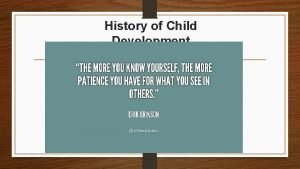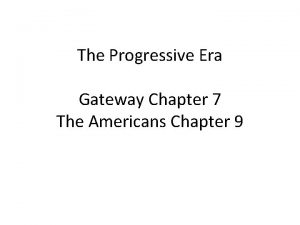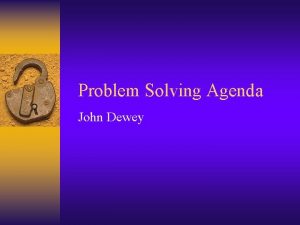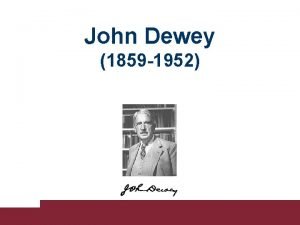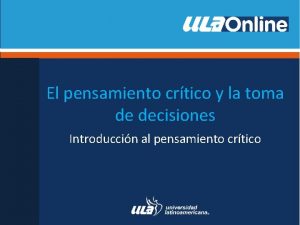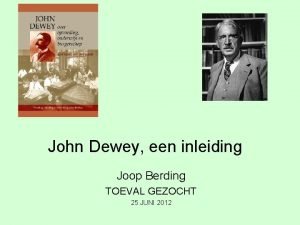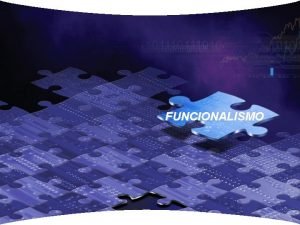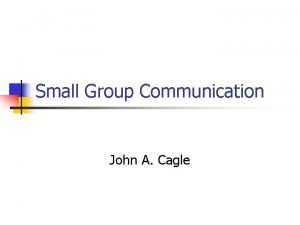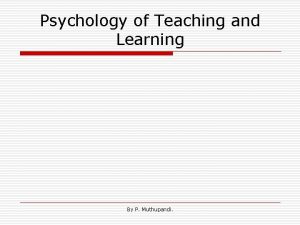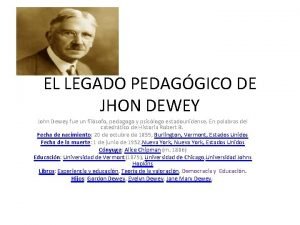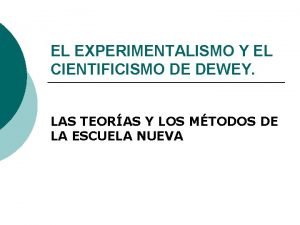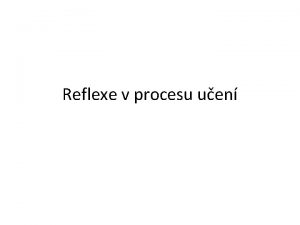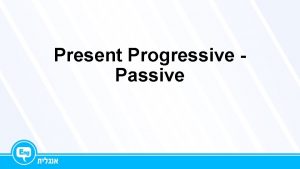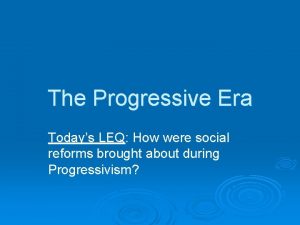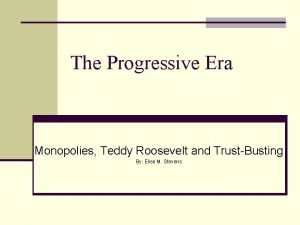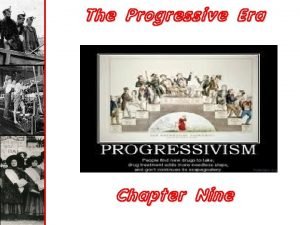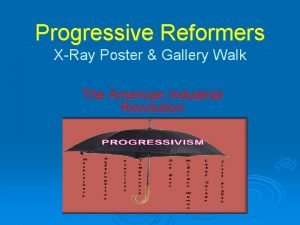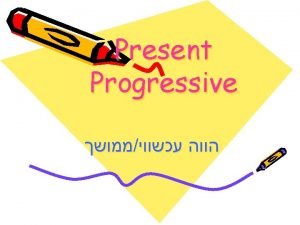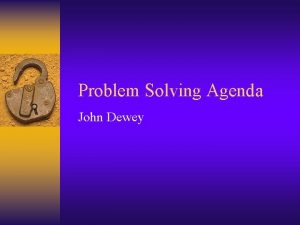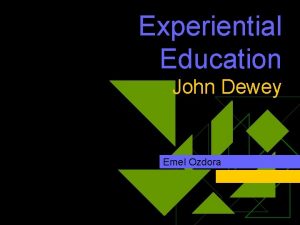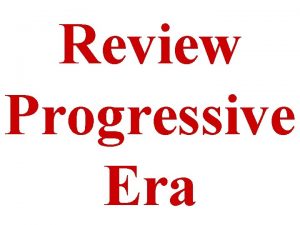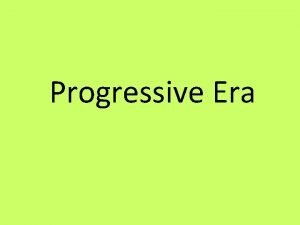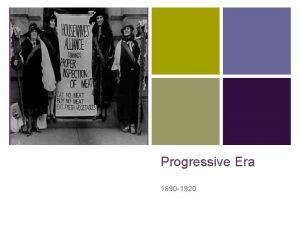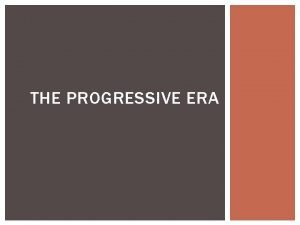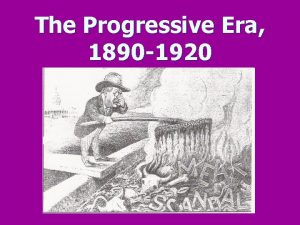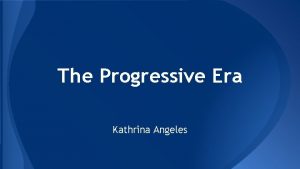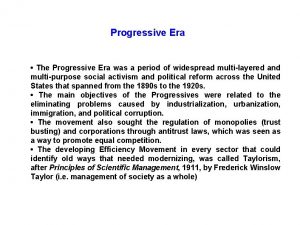History of Child Development Progressive Era John Dewey























- Slides: 23

History of Child Development

Progressive Era • John Dewey (1859 -1952) • “Father of Progressive Education” • Raised in Vermont, Dewey is the first real American influence on US education. • He felt that education should be integrated with life and should provide a training ground for cooperative living. • At this time childhood was rushed. Children as young as 7 were a part of the workforce on farms, in the mines, and in the factories. • His 6 th child (Jane Dewey) said: “His own schooling had bored him; he disliked the rigid, passive way of learning forced on children by the pervasive lecture-recitation method of that time.

Progressive Era Dewey’s Laboratory School A new kind of school emerged from these ideals. Even the buildings began to take on a different look. Movable furniture replaced rows of benches. Children’s projects, some still under construction, were found everywhere. The curriculum of the school began to focus on all of the basics, not just on a few of the academics. If a group of 6 -year-olds decided to make a woodworking table they would first have to learn how to read the instructions. After calculating the cost, they would purchase the materials. In building the table, geometry, physics, and math were learned along the way. This was a group effort that encouraged children to work together, so school became a miniature society. The teacher’s role in the process was one of ongoing support, involvement and encouragement. Pg. 18


Dewey’s Pedagogic Creed Dewey’s Creed: “I believe that only true education comes through the stimulation of the child’s powers by the demands of the social situations in which he finds himself. ” “The child’s own instinct and powers furnish the material and give the starting point for all education”. “I believe that education, therefore, is a process of living and not a preparation for future living”. “I believe that the school life should grow gradually out of the home life. It is the business of the school to deepen and extend the child’s sense of values bound up in his home life. ” “I believe that the teacher is engaged, not simply in the training of individuals, but in the formation of a proper social life. Every teacher should realize the dignity of his calling. ” What it means today: This tells us that children learn to manage themselves in groups, to make and share friendship, to solve problems and to cooperate. We need to create a place that is child-centered, a place that values the skills and interests of each child and each group. Prepare children for what is to come be enriching and interpreting the present to them. Find educational implications in everyday experiences. This sets the rationale for a relationship between teachers and parents. Values established and created in the home should be enhanced by teaching in the schools. This says that the work teachers do is important and valuable. They teach more than academic content; they teach how to live

Progressive Era • Sputnik and the War on Poverty: Head Start • After WWII, few innovations took place until a small piece of metal made its worldwide debut. Sputnik, the Soviet satellite, was successfully launched in 1957 and caused a commotion in education circles. • Two questions were in the minds of Americans. 1) Why were we not the first in space? and 2) What is wrong with our schools? • This war on poverty (centered on engineering, science and math) focused on helping disadvantaged preschool children gain competitive skills. • Head Start began in 1965 as a demonstration program aimed at providing educational, social, medical, dental, nutritional, and mental health services to preschool children from diverse populations of low income families.

(1896 -1934) Lev Vygotsky The Zone of Proximal Development (ZPD)

So what does it all mean? Lev Vygotsky believed that children learned from and with their peers and adults. He felt that when you combine the resources of each, new levels of learning could be mastered in more effective ways. Vygotsky showed us how the Zone of Proximal Development influences how children learn and develop.

d ll e ca g!! t! lso ldin hor a s ffo r s ’ t I ca fo S PD Z r O t en v a e l. D ro xim e A n Zo P of pm o el B

So, what else did he believe in? Observation Work Together Vygotsky saw teamwork as a necessary piece of education. He felt that what children could learn from each other, their shared experiences, and their explorations could not be re-created through instruction. Vygotsky believed that observation should be just as important (or more so) than test scores. The Whole Child Vygotsky believed that learning happens in every moment. They learned from doing, they learning by talking, they learned by working with friends, and they learned through persistence at a difficult task. It could not be structured into set aside times for “academics”. Life is learning. Interaction Vygotsky saw learning as a team sport and believed it absolutely necessary for cognitive development.

Thoughts: What if you were not allowed to use the tools of your classmates to reach new heights? What if you were told, “You can do this on your own, you don’t need help!” or even worse, “Figure it out for yourself, there will be no cheating!” You may spend hours, days or years trying to make the strip of tape stand up and make a building, with little to no improvement. By scaffolding with the tools each child or person is given you can increase learning and learn a valuable lesson in teamwork and collaboration. But, the teacher/educator needs to observe when children can do something independently and when it would be a benefit for them to work together. Consider the role observation plays within a child’s development. What if a teacher never fully observes the struggles of a child and just labels them “lazy, slow, or uninspired”? The teacher would be missing out on the opportunity to help a child build up their skill set so that they will continue to grow. It may be easier to ask a child to work independently for an “answer”, but life lessons are more than just “answers”. Take careful observations and gauge when you are needed and what you are needed for. Notice who could learn from each other and see that as a valuable teaching tool. How does this look in different settings? Work? School? Home?

https: //www. youtube. com/watch? v=f. DKDC_IUn. OA

Reflection Zone of Proximal Development B g n i old r o D ZP A ff a c S Cooking- I can make homemade spaghetti sauce! Driving. Freeways with the help of navigation

Reggio Emilia





100 Languages of Children

100 Pieces of YOU! Make a list of 100 things that define who you are. This can be physical traits (tall, curly hair, hazel eyes) or can be characteristics (funny, introvert), can be talents (athletic, artist) or based on relationships (daughter, husband). Anything!

Professionalism If you are thinking of working with young children as a career, perhaps you are wondering how early childhood education compares in prestige and importance with elementary or secondary education. Is it truly a profession for growth and change? Can a student preparing to work with young children today look forward to a challenging, intellectually, stimulating, and rewarding future in an early childhood profession? Why did we pick this field?

4 Aspects of Professionalism 1. Sense of identity: Early childhood professionals see themselves as caregivers who strive to educate the whole child, taking into consideration the body, the mind, the heart and the soul. 2. Purpose to engage in developmentally appropriate practices (DAP): What constitutes quality care and education calls for blending 3 knowledge bases: • Child Development knowledge • The strengths, interests, and needs of each child • The social and cultural contexts in which children live “Education is a right, not a race…. our goal is to prepare all children to be winners in their own lives”.

4 Aspects of Professionalism 3. Commitment to ethical teaching and child advocacy: Being a professional means behaving with a child’s best interests in mind, keeping confidentiality when discussing issues in the classroom and about families, upholding a code of ethics, and taking one’s self and work seriously. 4. Participation in the work as legitimate livelihood: Early childhood is more than glorified babysitting; the people who provide care and education to young children deserve wages and working conditions that are worthy of their efforts. “Aside from the traditional roles that teachers have assumed, they are now expected to serve as curriculum specialists, diagnosticians, health care providers, family counselors, adult educators, program managers, child development experts, child advocates, mental health specialists, nutrition specialists, and many others too numerous to list”.
 John dewey progressive era
John dewey progressive era Gateway to us history chapter 7 the progressive era
Gateway to us history chapter 7 the progressive era Dewey's problem solving method
Dewey's problem solving method John dewey biografia
John dewey biografia Strumentalismo di dewey pone al centro
Strumentalismo di dewey pone al centro John dewey theory
John dewey theory Pensamiento critico y toma de decisiones
Pensamiento critico y toma de decisiones John dewey theorie
John dewey theorie William james funcionalismo
William james funcionalismo John dewey’s reflective thinking model
John dewey’s reflective thinking model 700s dewey decimal system
700s dewey decimal system Definition of education according to john dewey
Definition of education according to john dewey Jhon dewey
Jhon dewey John dewey cónyuge
John dewey cónyuge Experimentalismo de john dewey
Experimentalismo de john dewey John dewey pragmatismus
John dewey pragmatismus Present progressive passive form
Present progressive passive form Past progressive affirmative
Past progressive affirmative Past progressive and past perfect progressive
Past progressive and past perfect progressive Progressive era leq
Progressive era leq What are mukrakers
What are mukrakers Trust busting progressive era
Trust busting progressive era Progressive era dbq answers
Progressive era dbq answers Progressive era posters
Progressive era posters
